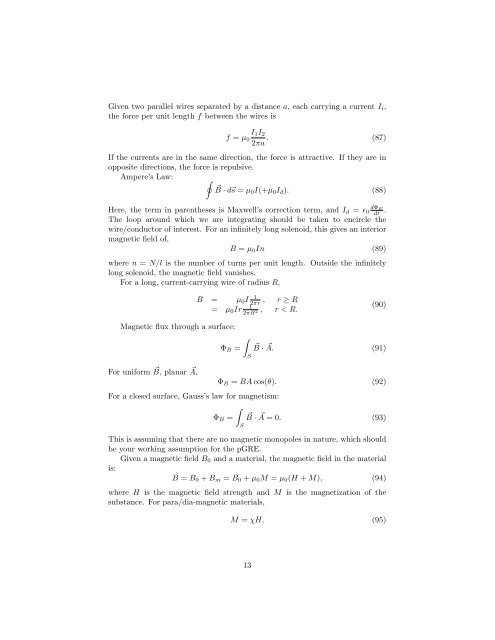Notes for the Physics GRE - Harvard University Department of Physics
Notes for the Physics GRE - Harvard University Department of Physics
Notes for the Physics GRE - Harvard University Department of Physics
Create successful ePaper yourself
Turn your PDF publications into a flip-book with our unique Google optimized e-Paper software.
Given two parallel wires separated by a distance a, each carrying a current I i ,<strong>the</strong> <strong>for</strong>ce per unit length f between <strong>the</strong> wires isf = µ 0I 1 I 22πa . (87)If <strong>the</strong> currents are in <strong>the</strong> same direction, <strong>the</strong> <strong>for</strong>ce is attractive. If <strong>the</strong>y are inopposite directions, <strong>the</strong> <strong>for</strong>ce is repulsive.Ampere’s Law: ∮⃗B · d⃗s = µ 0 I(+µ 0 I d ). (88)Here, <strong>the</strong> term in paren<strong>the</strong>ses is Maxwell’s correction term, and I d = ɛ 0dΦ Edt .The loop around which we are integrating should be taken to encircle <strong>the</strong>wire/conductor <strong>of</strong> interest. For an infinitely long solenoid, this gives an interiormagnetic field <strong>of</strong>,B = µ 0 In (89)where n = N/l is <strong>the</strong> number <strong>of</strong> turns per unit length. Outside <strong>the</strong> infinitelylong solenoid, <strong>the</strong> magnetic field vanishes.For a long, current-carrying wire <strong>of</strong> radius R,B = µ 0 I 12πr , r ≥ R= µ 0 Ir 12πR, r < R.2Magnetic flux through a surface:∫Φ B =For uni<strong>for</strong>m ⃗ B, planar ⃗ A,S(90)⃗B · ⃗A. (91)Φ B = BA cos(θ). (92)For a closed surface, Gauss’s law <strong>for</strong> magnetism:∫Φ B = ⃗B · ⃗A = 0. (93)SThis is assuming that <strong>the</strong>re are no magnetic monopoles in nature, which shouldbe your working assumption <strong>for</strong> <strong>the</strong> p<strong>GRE</strong>.Given a magnetic field B 0 and a material, <strong>the</strong> magnetic field in <strong>the</strong> materialis:B = B 0 + B m = B 0 + µ 0 M = µ 0 (H + M), (94)where H is <strong>the</strong> magnetic field strength and M is <strong>the</strong> magnetization <strong>of</strong> <strong>the</strong>substance. For para/dia-magnetic materials,M = χH, (95)13
















